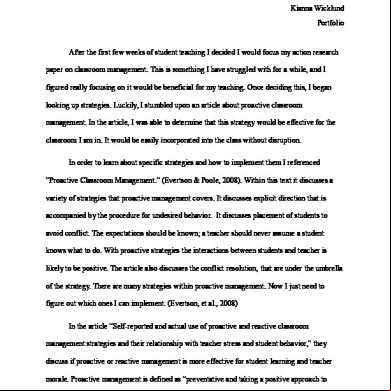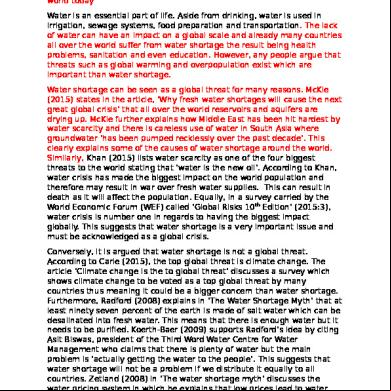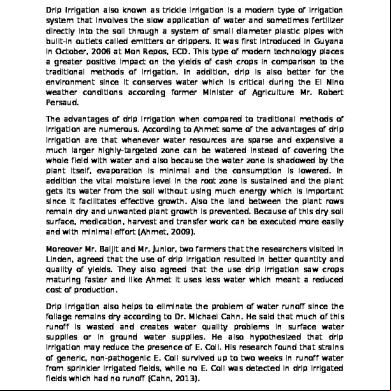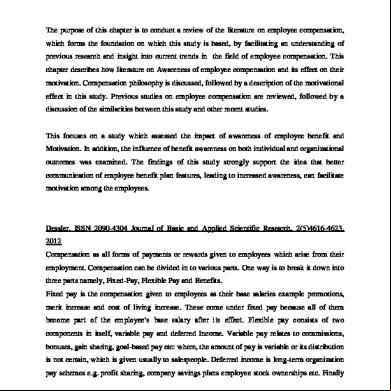Literature Review 54j4y
This document was ed by and they confirmed that they have the permission to share it. If you are author or own the copyright of this book, please report to us by using this report form. Report 2z6p3t
Overview 5o1f4z
& View Literature Review as PDF for free.
More details 6z3438
- Words: 1,216
- Pages: 5
Literature Review Kianna Wicklund Portfolio
After the first few weeks of student teaching I decided I would focus my action research paper on classroom management. This is something I have struggled with for a while, and I figured really focusing on it would be beneficial for my teaching. Once deciding this, I began looking up strategies. Luckily, I stumbled upon an article about proactive classroom management. In the article, I was able to determine that this strategy would be effective for the classroom I am in. It would be easily incorporated into the class without disruption. In order to learn about specific strategies and how to implement them I referenced “Proactive Classroom Management.” (Evertson & Poole, 2008). Within this text it discusses a variety of strategies that proactive management covers. It discusses explicit direction that is accompanied by the procedure for undesired behavior. It discusses placement of students to avoid conflict. The expectations should be known; a teacher should never assume a student knows what to do. With proactive strategies the interactions between students and teacher is likely to be positive. The article also discusses the conflict resolution, that are under the umbrella of the strategy. There are many strategies within proactive management. Now I just need to figure out which ones I can implement. (Evertson, et al., 2008) In the article “Self-reported and actual use of proactive and reactive classroom management strategies and their relationship with teacher stress and student behavior,” they discuss if proactive or reactive management is more effective for student learning and teacher morale. Proactive management is defined as “preventative and taking a positive approach to classroom management (Clunies-Ross, Little, & Kienhuis, 2008).” This is related to classroom
arrangement, teaching expectations and other preventative planning. In Australia, they surveyed 97 teachers, a majority of the teachers stated that proactive management is more effective and widely used. The study also showed that teachers who use reactive management are more negative to students in general. This negativity was linked to an increase in stress. It also was stated that this type of management is ineffective and undesired behavior perused. Teacher stress is relating mostly to student misbehavior and work load. The more effective your strategies are for managing a classroom the less likely the teacher will burn out. Proactive or preventative management is suggested to decrease the amount of disruptions and increase teacher morale. (Clunies-Ross et al., 2008) In an article that studied the knowledge and strategies used by preservice teachers, it was pointed out that the student teachers were not successfully managing their classrooms. The preservice teachers were using “yelling or screaming” (Kher, Lacina-Gifford, & Yandell, 2000) as their main strategy. These student teachers noted that it was not effective. They also felt as though they had no other options due to lack of guidance. The authors of this article repetitively stated that they desired for preventative strategies to be implemented. Unfortunately, the teachers were unable to effectively implement these strategies and the authors stated this would hold them back in future teaching endeavors. (Kher, et al., 2000) “Success and near misses: Pre-service teachers’ use, confidence and success in various classroom management strategies” (Reupert & Woodcock, 2010), was a Canadian study that was meant to improve educational programs. In this study they survey students at the end of student teaching and another group of students the semester before student teaching. They attempt to understand the strategies for management that teacher candidate uses or planned to use. Throughout the article they ascertain that many successful students use a blend of proactive
management and initial corrective strategies. While it was decided that proactive management was the best option due to more active learning and increase of student enjoyment, initial corrective strategies was also somewhat successful. It was seen that by the end of the student teaching semester teachers were directing their management towards preventative strategies. (Reupert et al., 2010) In the article “Psychology’s Contributions to Classroom Management” (Little & AkinLittle, 2008), the psychologists attempt to find the effective classroom management strategies for teachers. They consider both proactive and reactive strategies. For proactive they suggest using natural consequence that are clearly stated prior to undesired behavior. They also stress positive , planned classroom layout and explicit instruction for procedures taught within the lessons. For reactive they noted the following: yelling, sending to the office, calling home, long stare and ignoring. While it is impossible to use just proactive or reactive the study shows that proactive decreases disruptions, allows for less stress and promotes a more positive environment. Reactive has its positives as well, but without attempting to prevent disruptive behaviors. The said behaviors are bound to occur. Shouting out or distracting other student’s learning will occur without the proper procedures in place. (Little et al., 2008) In “Teachers’ use of Classroom Management Procedures in the United States and Greece: A Cross Culture Comparison” (Akin-Little, Little & Laniti, 2009), they used the same survey that was used in to previous article. Instead of just surveying the US, they also surveyed Athens, Greece. They asked teachers about their management strategies and what they found to be most effective. For the most part, the two cultures had very similar answers and similar demographics. In Greece, corporal punishment is still prominent, so there was a higher amount of occurrences in Greece than the US. Although there was still a shocking amount of corporal punishment in the
US, even though there is no evidence showing it is an effective strategy. They found the teachers prefer proactive management and find it to be more effective. They also deduced that teachers who take preventative measure tend to be less stressed due to less disruptive behavior. It is then inferred that there will be less chance for teacher burn out because disruptive students are a leading cause for burning out. (Akin-Little et al.,2009) Overall, I gained a lot of insight to effective classroom management. Based on my finding I feel that the proactive management is the best path for me to take. I can implement it easily. I have already noticed a huge difference in my management since implementing said strategy. Based on the article this method seems to be a good idea to ensure effective teaching and a positive classroom environment. I am very excited to execute my posttest and see the decrease in disruption and increase in effective teaching.
References Akin-Little, K., Little, S., & Laniti, M. (2009). Teachers’ use of classroom management procedures in the United States and Greece: A cross culture comparison. School of Psychology International, 28 (1). 53-62. http://spi.sagepub.com/content/28/1/53.abstract Clunies-Ross, P., Little, E., & Kienhuis, M. (2008). Self-reported and actual use of proactive and reactive classroom management strategies and their relationship with teacher stress and
student behavior. Educational Psychology, 28 (6). 693-710.
http://www.tandfonline.com/doi/abs/10.1080/01443410802206700#.Vwsjb4-cHIU Evertson, C., & Poole, I. (2008). Proactive classroom management. In T. Good (Edu).131-140. https://idoc-pub.futbolgratis.org/profile/Carolyn_Evertson/publication/268336996_ProaCtiV e_Classroom_management/links/54bfaee10cf28eae4a660962.pdf Kher, N., Lacina-Gifford, L., & Yandell, S. (2000). Preservice teachers’ knowledge of effective classroom management strategies: Defiant behavior. American Educational Research Association.1-8. http://files.eric.ed.gov/fulltext/ED444941.pdf Little, S., & Akin-Little, A. (2008). Psychology’s contributions to classroom management. Psychology in the Schools. 45 (3). 1-9. http://onlinelibrary.wiley.com/doi/10.1002/ pits.20293/abstract Reupert, A., & Woodcock, S. (2010). Success and near misses: Pre-service teachers’ use, confidence and success in various classroom management strategies. Teaching and Teacher Education. 26. 1261-1268. http://ro.uow.edu.au/edupapers/198/
After the first few weeks of student teaching I decided I would focus my action research paper on classroom management. This is something I have struggled with for a while, and I figured really focusing on it would be beneficial for my teaching. Once deciding this, I began looking up strategies. Luckily, I stumbled upon an article about proactive classroom management. In the article, I was able to determine that this strategy would be effective for the classroom I am in. It would be easily incorporated into the class without disruption. In order to learn about specific strategies and how to implement them I referenced “Proactive Classroom Management.” (Evertson & Poole, 2008). Within this text it discusses a variety of strategies that proactive management covers. It discusses explicit direction that is accompanied by the procedure for undesired behavior. It discusses placement of students to avoid conflict. The expectations should be known; a teacher should never assume a student knows what to do. With proactive strategies the interactions between students and teacher is likely to be positive. The article also discusses the conflict resolution, that are under the umbrella of the strategy. There are many strategies within proactive management. Now I just need to figure out which ones I can implement. (Evertson, et al., 2008) In the article “Self-reported and actual use of proactive and reactive classroom management strategies and their relationship with teacher stress and student behavior,” they discuss if proactive or reactive management is more effective for student learning and teacher morale. Proactive management is defined as “preventative and taking a positive approach to classroom management (Clunies-Ross, Little, & Kienhuis, 2008).” This is related to classroom
arrangement, teaching expectations and other preventative planning. In Australia, they surveyed 97 teachers, a majority of the teachers stated that proactive management is more effective and widely used. The study also showed that teachers who use reactive management are more negative to students in general. This negativity was linked to an increase in stress. It also was stated that this type of management is ineffective and undesired behavior perused. Teacher stress is relating mostly to student misbehavior and work load. The more effective your strategies are for managing a classroom the less likely the teacher will burn out. Proactive or preventative management is suggested to decrease the amount of disruptions and increase teacher morale. (Clunies-Ross et al., 2008) In an article that studied the knowledge and strategies used by preservice teachers, it was pointed out that the student teachers were not successfully managing their classrooms. The preservice teachers were using “yelling or screaming” (Kher, Lacina-Gifford, & Yandell, 2000) as their main strategy. These student teachers noted that it was not effective. They also felt as though they had no other options due to lack of guidance. The authors of this article repetitively stated that they desired for preventative strategies to be implemented. Unfortunately, the teachers were unable to effectively implement these strategies and the authors stated this would hold them back in future teaching endeavors. (Kher, et al., 2000) “Success and near misses: Pre-service teachers’ use, confidence and success in various classroom management strategies” (Reupert & Woodcock, 2010), was a Canadian study that was meant to improve educational programs. In this study they survey students at the end of student teaching and another group of students the semester before student teaching. They attempt to understand the strategies for management that teacher candidate uses or planned to use. Throughout the article they ascertain that many successful students use a blend of proactive
management and initial corrective strategies. While it was decided that proactive management was the best option due to more active learning and increase of student enjoyment, initial corrective strategies was also somewhat successful. It was seen that by the end of the student teaching semester teachers were directing their management towards preventative strategies. (Reupert et al., 2010) In the article “Psychology’s Contributions to Classroom Management” (Little & AkinLittle, 2008), the psychologists attempt to find the effective classroom management strategies for teachers. They consider both proactive and reactive strategies. For proactive they suggest using natural consequence that are clearly stated prior to undesired behavior. They also stress positive , planned classroom layout and explicit instruction for procedures taught within the lessons. For reactive they noted the following: yelling, sending to the office, calling home, long stare and ignoring. While it is impossible to use just proactive or reactive the study shows that proactive decreases disruptions, allows for less stress and promotes a more positive environment. Reactive has its positives as well, but without attempting to prevent disruptive behaviors. The said behaviors are bound to occur. Shouting out or distracting other student’s learning will occur without the proper procedures in place. (Little et al., 2008) In “Teachers’ use of Classroom Management Procedures in the United States and Greece: A Cross Culture Comparison” (Akin-Little, Little & Laniti, 2009), they used the same survey that was used in to previous article. Instead of just surveying the US, they also surveyed Athens, Greece. They asked teachers about their management strategies and what they found to be most effective. For the most part, the two cultures had very similar answers and similar demographics. In Greece, corporal punishment is still prominent, so there was a higher amount of occurrences in Greece than the US. Although there was still a shocking amount of corporal punishment in the
US, even though there is no evidence showing it is an effective strategy. They found the teachers prefer proactive management and find it to be more effective. They also deduced that teachers who take preventative measure tend to be less stressed due to less disruptive behavior. It is then inferred that there will be less chance for teacher burn out because disruptive students are a leading cause for burning out. (Akin-Little et al.,2009) Overall, I gained a lot of insight to effective classroom management. Based on my finding I feel that the proactive management is the best path for me to take. I can implement it easily. I have already noticed a huge difference in my management since implementing said strategy. Based on the article this method seems to be a good idea to ensure effective teaching and a positive classroom environment. I am very excited to execute my posttest and see the decrease in disruption and increase in effective teaching.
References Akin-Little, K., Little, S., & Laniti, M. (2009). Teachers’ use of classroom management procedures in the United States and Greece: A cross culture comparison. School of Psychology International, 28 (1). 53-62. http://spi.sagepub.com/content/28/1/53.abstract Clunies-Ross, P., Little, E., & Kienhuis, M. (2008). Self-reported and actual use of proactive and reactive classroom management strategies and their relationship with teacher stress and
student behavior. Educational Psychology, 28 (6). 693-710.
http://www.tandfonline.com/doi/abs/10.1080/01443410802206700#.Vwsjb4-cHIU Evertson, C., & Poole, I. (2008). Proactive classroom management. In T. Good (Edu).131-140. https://idoc-pub.futbolgratis.org/profile/Carolyn_Evertson/publication/268336996_ProaCtiV e_Classroom_management/links/54bfaee10cf28eae4a660962.pdf Kher, N., Lacina-Gifford, L., & Yandell, S. (2000). Preservice teachers’ knowledge of effective classroom management strategies: Defiant behavior. American Educational Research Association.1-8. http://files.eric.ed.gov/fulltext/ED444941.pdf Little, S., & Akin-Little, A. (2008). Psychology’s contributions to classroom management. Psychology in the Schools. 45 (3). 1-9. http://onlinelibrary.wiley.com/doi/10.1002/ pits.20293/abstract Reupert, A., & Woodcock, S. (2010). Success and near misses: Pre-service teachers’ use, confidence and success in various classroom management strategies. Teaching and Teacher Education. 26. 1261-1268. http://ro.uow.edu.au/edupapers/198/





